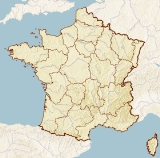
Candas
Encyclopedia
Candas is a commune
in the Somme
department in Picardie
in northern France
.
.
The sails stopped turning in 1923, on the death of the last miller, Louis Fanchon (who acquired the mill in 1882). The building was left to nature, and was soon covered in moss and grass, with bushes growing through every opening. Much of the structure began to crumble.
After more than 10 years restoration, thanks to the dynamism of the Association de Sauvegarde du Patrimoine de Candas, the mill is now open to the public. There’s a guided tour and demonstrations of flour production.
Communes of France
The commune is the lowest level of administrative division in the French Republic. French communes are roughly equivalent to incorporated municipalities or villages in the United States or Gemeinden in Germany...
in the Somme
Somme
Somme is a department of France, located in the north of the country and named after the Somme river. It is part of the Picardy region of France....
department in Picardie
Picardie
Picardy is one of the 27 regions of France. It is located in the northern part of France.-History:The historical province of Picardy stretched from north of Noyon to Calais, via the whole of the Somme department and the north of the Aisne department...
in northern France
France
The French Republic , The French Republic , The French Republic , (commonly known as France , is a unitary semi-presidential republic in Western Europe with several overseas territories and islands located on other continents and in the Indian, Pacific, and Atlantic oceans. Metropolitan France...
.
Geography
Candas is situated on the D31 and D49 crossroads, some 21 miles (34 km) north of AmiensAmiens
Amiens is a city and commune in northern France, north of Paris and south-west of Lille. It is the capital of the Somme department in Picardy...
.
Places of interest
- Fanchon’s windmill
The sails stopped turning in 1923, on the death of the last miller, Louis Fanchon (who acquired the mill in 1882). The building was left to nature, and was soon covered in moss and grass, with bushes growing through every opening. Much of the structure began to crumble.
After more than 10 years restoration, thanks to the dynamism of the Association de Sauvegarde du Patrimoine de Candas, the mill is now open to the public. There’s a guided tour and demonstrations of flour production.

